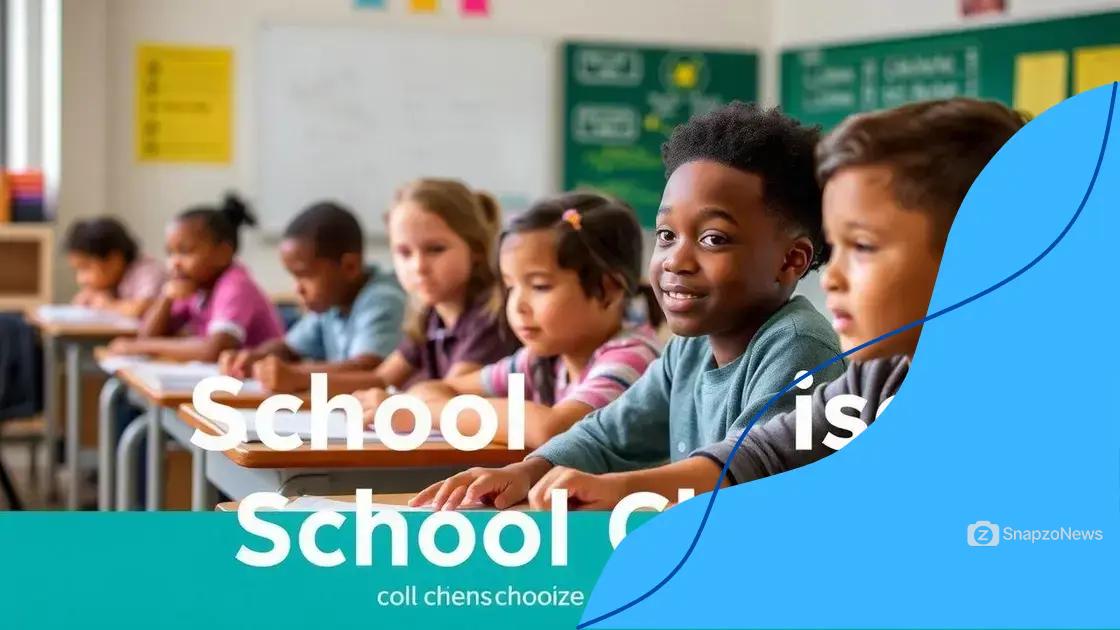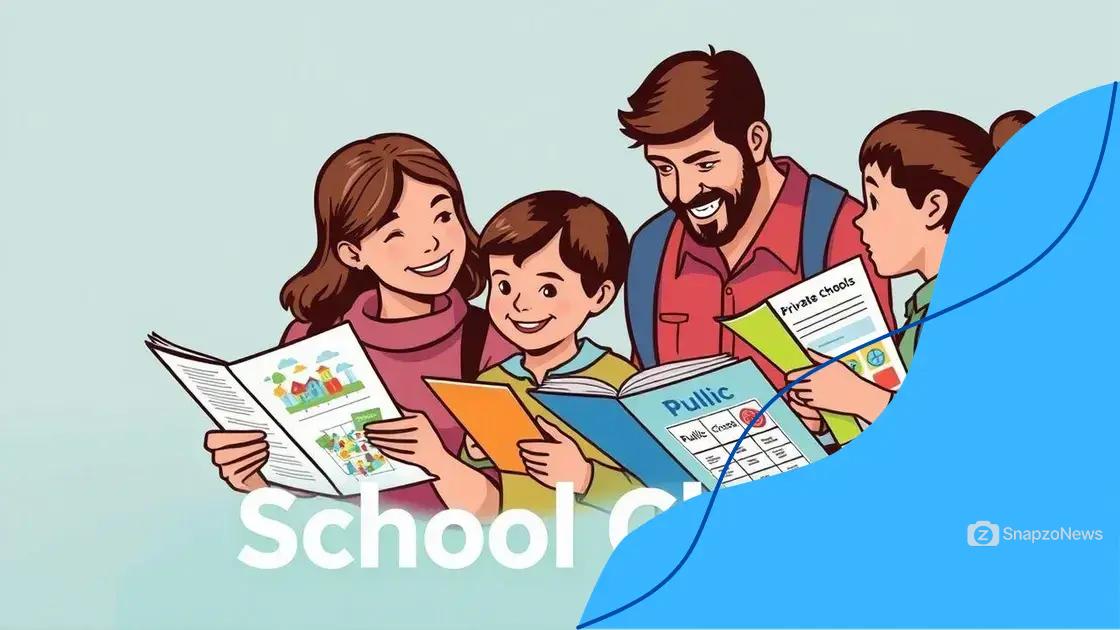The debate over school choice and vouchers: what you need to know

School choice allows parents to select educational options for their children, including public, private, and charter schools, impacting educational quality, community engagement, and resource allocation.
The debate over school choice and vouchers continues to spark heated discussions nationwide. Many parents wonder how these policies affect their children’s education and what options they really have. Let’s dive into the topic and explore the implications.
Understanding school choice options
Understanding school choice options is crucial for parents and students alike. In recent years, the landscape of education has changed dramatically, providing a multitude of choices beyond traditional public schools.
Parents now face various options that can significantly impact their child’s learning journey. Each choice offers unique benefits and challenges, which is why it’s essential to dive deeper into each option available.
Types of School Choice
The following types of school choice avenues are worth exploring:
- Charter Schools: These public schools operate independently of the traditional school district structure, allowing for innovative teaching methods and curriculum.
- Magnet Schools: Designed to draw students from various districts, magnet schools focus on specific themes like science, arts, or technology.
- Private Schools: Funded through tuition payments and donations, these institutions often have more flexibility regarding curricula and teaching methods.
- Homeschooling: An increasingly popular option, homeschooling allows parents to tailor the education to their child’s needs and interests directly.
Understanding these options helps parents make informed decisions. Each choice can lead to different educational experiences based on the child’s unique needs. For instance, charter schools often have a strong focus on innovative teaching, while magnet schools provide specialized programs that cater to specific talents.
Factors to Consider
When weighing school choice options, it’s essential to consider several factors:
- Location: Proximity to home can affect daily commutes for kids and parents.
- Curriculum: Look for programs that align with your child’s interests and learning styles.
- Diversity: A diverse environment can enrich the educational experience.
- Funding: Consider the financial implications of tuition and additional fees.
As you explore these choices, remember that what works for one family may not be ideal for another. Prioritizing your child’s specific needs is vital for their success. Engaging in conversations with other parents and school administrators can provide valuable insights, helping guide your decision-making process.
The role of vouchers in education
The role of vouchers in education has become a hot topic in discussions about school choice. These vouchers are financial aids that allow families to use public funding for private school tuition. As more parents seek alternatives to traditional public schools, understanding how vouchers work is essential.
Vouchers can offer significant benefits. They provide families with the freedom to choose schools that best fit their children’s needs. This option can lead to a more personalized educational experience. However, the implementation of voucher programs is not without challenges.
How Vouchers Work
A voucher system allows parents to receive funds that they can apply toward tuition at a school of their choice. This can include:
- Private schools: Families can send their children to private institutions without bearing the entire cost.
- Charter schools: Some vouchers can be used for public charter schools that operate with more autonomy than traditional public schools.
- Specialized programs: Vouchers can also be used for schools that focus on specific curriculums, such as arts or sciences.
Understanding the impact of vouchers on education is crucial. Advocates argue that vouchers promote competition among schools, potentially leading to improved academic outcomes. However, critics raise concerns about public funding being funneled to private schools at the expense of public education.
Potential Advantages and Disadvantages
Exploring the pros and cons of voucher programs helps inform the debate:
- Advantages:
- Increased choice for parents and students.
- Potential for improved educational outcomes through competition.
- Access to specialized educational programs that might not be available in local schools.
- Disadvantages:
- Funding could detract from public school resources.
- Vouchers may not cover all costs, limiting options for some families.
- The quality of private institutions can vary widely.
The conversation about vouchers continues to evolve, influencing education policy across the nation. As debates rage on, the goal remains clear: ensuring every child has access to a quality education that meets their unique needs.
Pros and cons of school choice

Pros and cons of school choice are essential to consider when discussing education options. School choice can greatly influence a child’s education, making it important to weigh the advantages and disadvantages carefully.
On one hand, school choice offers families the ability to select an educational path that best fits their child’s needs. Some of the notable benefits include:
Advantages of School Choice
- Personalized Education: Families can find schools that cater specifically to their child’s learning style or interests.
- Increased Competition: With more options, schools may improve their quality to attract students.
- Access to Specialized Programs: Families can choose institutions that offer specialized curriculums, such as STEM or arts-focused education.
- Empowered Families: Parents gain a voice in their child’s education, fostering a sense of involvement and investment.
While there are significant advantages, it is also important to consider the disadvantages associated with school choice. These can include:
Disadvantages of School Choice
- Equity Concerns: Not all families have equal access to resources necessary for choosing alternatives, which can create disparities.
- Funding Issues: Public schools may suffer from budget cuts as funds are diverted to support school choice initiatives.
- Quality Variation: Not all schools provide a high-quality education, making it crucial for families to research their options carefully.
- Increased Pressure: Families may feel overwhelmed by choices and the need to select the “right” school.
The discussion around school choice is ongoing, with advocates and critics presenting powerful arguments on both sides. By understanding the pros and cons, parents can make informed decisions that align with their child’s unique needs and circumstances, contributing to the broader dialogue about educational equity.
How school choice impacts communities
How school choice impacts communities is an essential discussion in today’s education landscape. Choices made by families regarding education can resonate beyond individual households and significantly influence the broader community.
School choice can foster a sense of involvement among parents. When families select schools, they often become more engaged in community activities and governance. This engagement can lead to improved resources and educational opportunities within the community. Understanding the effects on various aspects of community life is crucial.
Positive Impacts
Some positive impacts of school choice on communities include:
- Diverse Educational Options: Communities may benefit from a range of schools that offer specialized programs catering to different interests and learning styles.
- Boost in Community Engagement: Greater parent involvement can lead to more volunteer opportunities, enhancing community spirit.
- Economic Growth: New schools, especially charter and private institutions, can create jobs and bring funding into the community.
- Collaborative Initiatives: Schools often partner with local businesses and organizations, leading to community programs and events.
However, school choice can also have negative ramifications for communities. It’s important to address these potential issues as well.
Negative Impacts
Some challenges that may arise from school choice include:
- Resource Allocation: Public schools might face budget cuts, negatively impacting the quality of education for students who remain in those schools.
- Increased Segregation: School choice can sometimes lead to socio-economic or racial divides within communities, affecting overall cohesion.
- Pressure on Public Schools: With the rise of charter or private schools, traditional public schools may struggle to meet performance standards without adequate funding.
- Loss of Local Control: As families migrate toward preferred schools, local districts might find it challenging to maintain control and accountability.
Community leaders must carefully consider these factors when discussing educational policies. Engaging in open conversations about the implications of school choice can help communities navigate the complexities presented by a changing education system.
Future of school choice policies
Future of school choice policies is a topic that continues to evolve as educational needs change. Policymakers, educators, and families are all watching closely to see how these policies will develop. Understanding what lies ahead helps stakeholders prepare for the implications of school choice.
As technology and society evolve, the landscape of education is also transforming. The future of school choice may see an expansion in options available to families. This includes not only traditional public and private schools but also online learning and hybrid models. Here’s what to consider regarding potential changes.
Emerging Trends in School Choice
Several key trends may shape the future of school choice policies:
- Increased Online Education: With the growth of online learning, more parents may opt for virtual education options that fit their schedules.
- Emphasis on Equity: Future policies may focus more on equity, ensuring that all families have access to quality educational options regardless of their economic status.
- Personalized Learning: Expect a shift towards personalized learning experiences, tailored individually for students based on their unique needs.
- Community Involvement: Policies may encourage greater involvement from community members in the decision-making process, promoting transparency and accountability.
In addition to these trends, the legislative landscape will play a significant role in shaping school choice policies. Advocacy groups will likely engage more in discussions with lawmakers, and public opinion will continue to influence decisions.
The Role of Technology
Technology will undoubtedly play a critical role in the future of education. As tools become more sophisticated, they may enhance learning opportunities. This could lead to more effective online programs, contributing to better outcomes for students who prefer virtual learning environments.
The dialogue around school choice policies is constantly shifting, and it’s vital for parents and educators to stay informed. Understanding possible futures can lead to more informed choices for students and families alike. Engaging in discussions about these potential changes is crucial for shaping a more equitable education system.
FAQ – Frequently Asked Questions about School Choice Policies
What is school choice?
School choice allows parents to select the educational institutions their children attend, which can include public, private, charter, or homeschooling options.
What are the benefits of school choice?
Benefits of school choice include personalized education options, increased parental engagement, and greater access to specialized programs.
Are there any downsides to school choice?
Yes, potential downsides include equity concerns, resource allocation issues in public schools, and the risk of increased segregation.
How can I get involved in school choice policy discussions?
You can participate by attending community meetings, joining local advocacy groups, and communicating with policymakers about educational needs.
